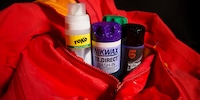
Background information
How to waterproof your outdoor clothing
by Siri Schubert
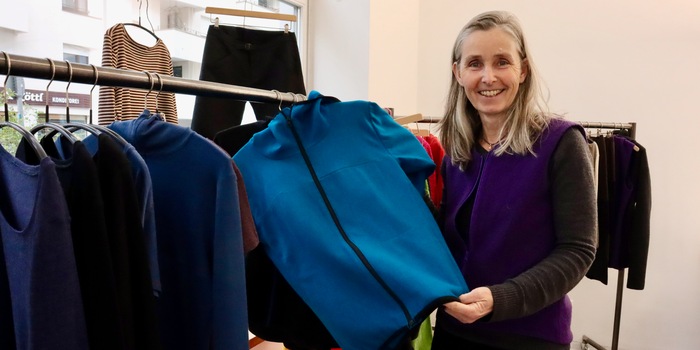
Seamstress and fashion designer Barbara Heinze has been involved with outdoor clothing for almost her entire life. As a passionate mountain sports enthusiast, she knows what makes good clothing. And how to care for your outdoor clothing so that it lasts longer.
Barbara Heinze is a passionate outdoor athlete. She’s been climbing, going on mountain and ski tours and cycling from an early age. Barbara loves nature, but also knows that specialist clothing can harm the environment. That’s why she’s constantly looking for solutions to make outdoor clothing more environmentally friendly.
The trained seamstress – who studied fashion graphics at the Munich University of Applied Sciences – draws her knowledge from a long career in the outdoor textile industry. She’s worked for major brands such as Patagonia, Benetton, WL Gore & Associates, Ortovox, Mountain Equipment, Salewa and Schöffel.
In 2008, she founded her own company (website in German). Since then, she’s been designing and making long-lasting, individual and sustainable clothing in her studio in Munich. She’s also developed her own sustainable outdoor clothing line for children. In her designs she uses merino wool, linen, hemp, organic cotton and – if a water-resistant, breathable material is required – Sympatex, a Blue Sign-certified weather protection membrane, or Eta Proof, a tightly woven, long-fibre cotton. The textiles expert also repairs branded outdoor clothing.
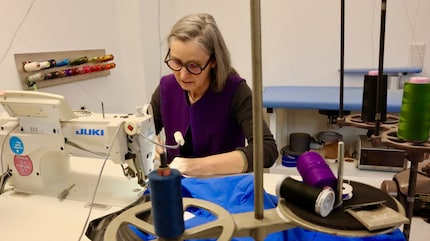
At Patagonia, Barbara was one of the key figures involved in the Worn Wear repair initiative for Europe right from its inception. In addition to the conceptual work, she sat in the repair truck at several outdoor trade fairs and later in Patagonia’s Tiny House and mended outdoor clothing to extend the life of jackets, trousers and backpacks which had tears and other damage. Using sustainable materials is only one aspect of making outdoor clothing more environmentally friendly. Another is extending the life of the clothing.
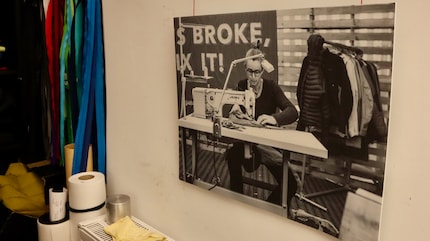
Specially designed outdoor clothing is increasingly being criticised for not being particularly environmentally friendly. What can outdoor athletes do to be as environmentally friendly as possible?
Barbara Heinze: The first step is to look for durable, high quality products and how easy they are to repair when buying. Of course, maintenance is also important so that the trousers and jackets last as long as possible. The salt and grease in our sweat are quite aggressive and break down the plastic in the outer layers, but especially the polyurethane adhesive in multi-layer laminates and the tapes on seams. The membrane also becomes brittle, with the plastic particles then shedding like snow. This is a real issue for waterproofing, so it’s important to wash outdoor clothing regularly.
What does regularly mean in this context?
It all depends on how intensively you use your jacket. If you wear it on ski tours and sweat a lot, for example, you’ll need to wash it more often. I tell my customers that if they notice marks on the collar or cuffs, it’s high time for a wash. It’s best to use bio detergent. Not for hygiene reasons, but to extend the life of the clothing. This applies not only to waterproof outdoor jackets with membranes, but also to down jackets. If they’re not washed often enough, the fabric will develop small holes and the down will come out. If they’re well cared for, however, they’ll last a very long time.
I don’t think many people know that. There’s a perception that jackets should be washed as little as possible in order to protect them.
It’s not good for the waterproofing at all if the chemically treated particles shed, because it makes the jacket brittle. This happens when it’s not washed often enough. The fear is that washing will dissolve the DWR treatment – that’s the water-repellent coating. This is partly true, but it can be easily refreshed with PFC-free products that don’t contain harmful per- and polyfluorinated chemicals.
What else can I do if microplastics are leaching out of my jacket?
Nothing. You shouldn’t even be wearing it to walk the dog. Many people wear their laminate jackets – i.e. waterproof, breathable jackets with a membrane – for too long without washing them. When people bring them to me, I tell them that they have to be thrown out immediately, otherwise they’re a real burden on the environment. Otherwise, of course, I try to repair almost everything. And if a well-maintained and otherwise harmless item of clothing really can’t be saved, I make small items like bags or wallets out of it.
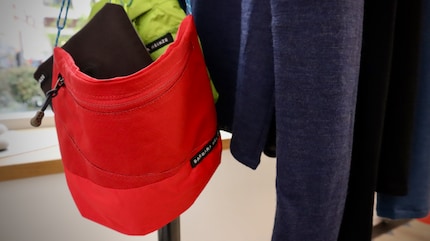
What does it take to be good at repairing clothes?
It’s helpful to be a seamstress, as I have a greater basic understanding than someone who sews as a hobby. This includes how a piece of clothing is constructed and how I can best address a tear in the hood, for example. I’m still learning because outdoor clothing has changed a lot in the last ten years. And it makes me happy when I can give the customer their well-repaired clothing back and they can then use it again. That doesn’t mean that non-professionals can’t do it, but it could be a bit more laborious and the materials required are unavailable or hard to find in shops. Sewing is definitely always better than trying to use liquid glue, which often renders even a professional repair impossible.
What advice would you give to people who want to repair their outdoor clothing at home on a sewing machine?
Almost anyone can carry out simple repairs on a household sewing machine. Working with unfamiliar materials is then more a matter of courage. That’s why it’s helpful to look at the materials in depth. I’m not against it at all. On the contrary, I think it’s great when people take the initiative themselves. It’s just different from a professional repair, just as there’s a difference between playing a sport with professional equipment and things you’ve picked up at the supermarket.
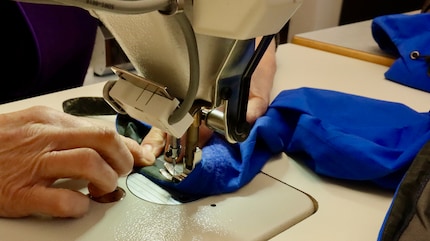
What motivated you to look for sustainable alternatives in outdoor clothing?
During my work in the textile and outdoor industry, I realised what a negative impact clothing manufacturing has on our environment. This ranges from pesticides in cotton cultivation to water consumption and the use of chemicals for colour preparation, dyeing and finishing. Added to this are the sometimes catastrophic working conditions in factories and low recyclability of practical clothing. Then there are also the chemicals used to make clothing water- and oil-repellent. This made me rethink things, and I asked myself what I could do about it. I found real alternatives in natural, organic and renewable raw materials and in Blue Sign-certified synthetic fibres. It’s also important to me to extend the lifecycle of clothing and to repair it where possible.
Sustainability has also become a hot topic in the outdoor industry. Many manufacturers now make functional shirts or backpacks out of recycled PET bottles. What are your thoughts on that?
I don’t think it makes sense because the plastic is taken from a cycle whose goal is to produce recyclable PET bottles. Tiny particles of polyester clothing that shed during washing can end up in the water as microplastics. There are also still no sensible recycling solutions for clothing because it’s too time-consuming to divide it into its various components. Work is being done on this, but we’re not there yet. So, clothing made from recycled PET bottles is pointless.
And then there’s the other issue: chemicals.
Yes, they’re a big problem. PFAs (per- and polyfluorinated alkyl compounds) are often used in the membranes of waterproof and breathable clothing. The forever chemicals – so called because they pollute the environment practically forever – are extremely harmful. I don’t use them at all.
What alternatives do you use?
When it comes to membranes, Sympatex is a good alternative because it doesn’t contain PFAs and is still waterproof and breathable. Otherwise, depending on what the clothing’s used for, I use organic cotton – such as Eta-Proof from Switzerland – wool, loden, recycled fleece or taffeta and hemp. Hemp’s interesting because it’s a hollow fibre that can absorb a lot of moisture without underwear starting to feel wet and cold on ski tours, for example. Hemp is also very tear-resistant.
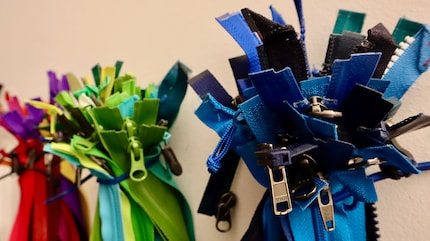
What else do you focus on in the clothes you make?
I make garments to measure so that jackets, trousers and functional shirts fit perfectly and allow sufficient freedom of movement. I can also factor in customers’ wishes for hoods, an extra pocket or a certain leg length. If the clothing fits well, it’s also pleasantly warm. And tailor-made clothing made of natural fibres that is well cared for also lasts longer than conventional outdoor clothing. Which also makes it sustainable.
Thank you, Barbara, for a fascinating interview and giving us an insight into the world of outdoor clothing.
Research diver, outdoor guide and SUP instructor – I love being in, on and around water. Lakes, rivers and the ocean are my playgrounds. For a change of perspective, I look at the world from above while trail running or flying drones.
Interesting facts about products, behind-the-scenes looks at manufacturers and deep-dives on interesting people.
Show all